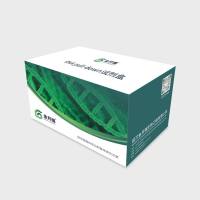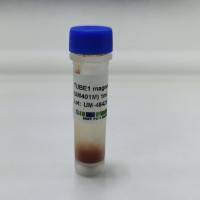Fluorescence Quenching Methods to Study Lipid‐Protein Interactions
互联网
- Abstract
- Table of Contents
- Materials
- Figures
- Literature Cited
Abstract
This unit describes how fluorescence quenching methods can be used to determine binding constants for phospholipids binding to intrinsic membrane proteins. Reconstitution of a Trp?containing intrinsic membrane protein with bromine?containing phospholipids leads to quenching of the Trp fluorescence of the protein; the extent of quenching depends on the strength of binding of the phospholipid to the protein. Protocols are included for the synthesis of bromine?containing phospholipids from phospholipids containing carbon?carbon double bonds in their fatty acyl chains and for the reconstitution of membrane proteins into bilayers containing bromine?containing phospholipids. Details are included on data analysis, including equations and software that can be used for fitting the fluorescence quenching data.
Keywords: Lipid?protein interactions; reconstitution; membrane proteins; fluorescence; phospholipid synthesis; bromination
Table of Contents
- Basic Protocol 1: Reconstitution of A Membrane Protein into DOPC and BrPC and Measurement of Fluorescence Quenching Efficiency
- Basic Protocol 2: Measurement of the Relative Lipid‐Binding Constant of A Membrane Protein Using Fluorescence Quenching
- Support Protocol 1: Preparation of Brominated Lipid
- Support Protocol 2: Analysis of Brominated Phospholipid by Mass Spectrometry
- Support Protocol 3: Purification of Potassium Cholate
- Reagents and Solutions
- Commentary
- Literature Cited
- Figures
- Tables
Materials
Basic Protocol 1: Reconstitution of A Membrane Protein into DOPC and BrPC and Measurement of Fluorescence Quenching Efficiency
Materials
Basic Protocol 2: Measurement of the Relative Lipid‐Binding Constant of A Membrane Protein Using Fluorescence Quenching
Materials
Support Protocol 1: Preparation of Brominated Lipid
Materials
Support Protocol 2: Analysis of Brominated Phospholipid by Mass Spectrometry
Materials
Support Protocol 3: Purification of Potassium Cholate
Materials
|
Figures
-
Figure 19.12.1 Lipid binding to an integral membrane protein. The figure shows lipid molecules (small circles) binding to part of the hydrophobic surface of a membrane protein. The lipid‐binding sites are referred to as annular or boundary sites. For a protein reconstituted into a mixture of two types of lipid, A and B, each of the lipid‐binding sites is occupied by either lipid A or by lipid B, The equilibrium is described by an equilibrium constant K given by: K = [Protein·A][B]/([Protein·B][A]). Here [A] and [B] are, respectively, the mole fractions of lipids A and B not bound to the protein and [Protein·A] and [Protein·B] are the fractions of the lipid‐binding site occupied by A and B, respectively. In this example, two of the sites occupied by lipid molecules, shown by the dark circles, are sufficiently close to the Trp residue (W) that binding of brominated lipid to either of the sites will quench the fluorescence of the Trp residue. In this case, therefore, n = 2. View Image -
Figure 19.12.2 Fluorescence emission spectra for KcsA in buffer (a, dotted line) and after reconstitution into DOPC (b) and BrPC (c). The lower fluorescence intensity in BrPC shows fluorescence quenching. The protein concentration was 0.75 µM and the molar ratio of lipid:KcsA was 100:1. View Image -
Figure 19.12.3 Negative ion electrospray mass spectrum of di(9,10‐dibromostearoyl)phosphatidylcholine in the presence of HCl, showing the peak at 1140.4 corresponding to the (M+Cl)− species. Insert: expanded mass scale showing the isotope cluster for (M+Cl)− . View Image -
Figure 19.12.4 Effect of n , the number of lipid‐binding sites on the protein from which a bound BrPC molecule can quench the fluorescence of a given Trp residue in a protein. The figure shows a set of theoretical quenching curves for a membrane protein reconstituted into bilayers containing mixtures of DOPC and BrPC, showing values of F / F o calculated from Equation with the given values of n , for a value of F min of 0.25. View Image -
Figure 19.12.5 The figure shows a set of theoretical quenching curves for a membrane protein reconstituted into bilayers containing mixtures of lipid X and BrPC, showing values of F / F o calculated from Equation with n = 1.69, for a value of F min of 0.25, for the given values of the binding constant of lipid X relative to BrPC. View Image -
Figure 19.12.6 Experimental fluorescence quenching plots. KcsA was reconstituted into mixtures of DOPC and BrPC (A ) and DOPE and BrPC (B ). Fluorescence intensities are expressed as F/Fo where Fo is the fluorescence intensity in the nonbrominated lipid. The solid line in (A) shows a fit to Equation , giving a value for n of 1.66 ± 0.12. The solid line in (B) shows a fit to Equation giving a value for the relative binding constant K for DOPE of 0.57 ± 0.09. View Image
Videos
Literature Cited
| Literature Cited | |
| Alvis, S.J., Williamson, I.M., East, J.M., and Lee, A.G. 2003. Interactions of anionic phospholipids and phosphatidylethanolamines with the potassium channel KcsA. Biophys. J. 85:1‐11. | |
| Bergelson, L.D. 1980. Lipid Biochemical Preparations. Elsevier/North Holland, Amsterdam. | |
| Caffrey, M. and Feigenson, G.W. 1981. Fluorescence quenching in model membranes. 3. Relationship between calcium adenosinetriphosphatase enzyme activity and the affinity of the protein for phosphatidylcholines with different acyl chain characteristics. Biochemistry 20:1949‐1961. | |
| Doyle, D.A., Cabral, J.M., Pfuetzner, R.A., Kuo, A., Gulbis, J.M., Cohen, S.L., Chait, B.T., and Mackinnon, R. 1998. The structure of the potassium channel: Molecular basis of K+ conduction and selectivity. Science 280:69‐77. | |
| East, J.M. and Lee, A.G. 1982. Lipid selectivity of the calcium and magnesium ion dependent adenosinetriphosphatase, studied with fluorescence quenching by a brominated phospholipid. Biochemistry 21:4144‐4151. | |
| East, J.M., Melville, D., and Lee, A.G. 1985. Exchange rates and numbers of annular lipids for the calcium and magnesium ion dependent adenosinetriphosphatase. Biochemistry 24:2615‐2623. | |
| Froud, R.J., East, J.M., Rooney, E.K., and Lee, A.G. 1986. Binding of long‐chain alkyl derivatives to lipid bilayers and to (Ca2+−Mg2+)‐ATPase. Biochemistry 25:7535‐7544. | |
| Lee, A.G. 2004. How lipids affect the activities of integral membrane proteins. Biochim. Biophys. Acta 1666:62‐87. | |
| London, E. and Feigenson, G.W. 1981. Fluorescence quenching in model membranes. 2. Determination of local lipid environment of the calcium adenosinetriphosphatase from sarcoplasmic reticulum. Biochemistry 20:1939‐1948. | |
| Mall, S., Sharma, R.P., East, J.M., and Lee, A.G. 1998. Lipid‐protein interactions in the membrane: Studies with model peptides. Faraday Discuss. 111:127‐136. | |
| Marsh, D. and Horvath, L.I. 1998. Structure, dynamics and composition of the lipid‐protein interface: Perspectives from spin‐labelling. Biochim. Biophys. Acta 1376:267‐296. | |
| O'Keeffe, A.H., East, J.M., and Lee, A.G. 2000. Selectivity in lipid binding to the bacterial outer membrane protein OmpF. Biophys. J. 79:2066‐2074. | |
| Pilot, J.D., East, J.M., and Lee, A.G. 2001. Effects of bilayer thickness on the activity of diacylglycerol kinase of Escherichia coli. Biochemistry 40:8188‐8195. | |
| Powl, A.M., East, J.M., and Lee, A.G. 2003. Lipid‐protein interactions studied by introduction of a tryptophan residue: The mechanosensitive channel MscL. Biochemistry 42:14306‐14317. | |
| Powl, A.M., East, J.M., and Lee, A.G. 2005. Heterogeneity in the binding of lipid molecules to the surface of a membrane protein: Hot‐spots for anionic lipids on the mechanosensitive channel of large conductance MscL and effects on conformation. Biochemistry 44:5873‐5883. | |
| Simmonds, A.C., East, J.M., Jones, O.T., Rooney, E.K., McWhirter, J., and Lee, A.G. 1982. Annular and non‐annular binding sites on the (Ca2+ + Mg2+)‐ATPase. Biochim. Biophys. Acta 693:398‐406. | |
| Williamson, I.M., Alvis, S.J., East, J.M., and Lee, A.G. 2002. Interactions of phospholipids with the potassium channel KcsA. Biophys. J. 83:2026‐2038. |







